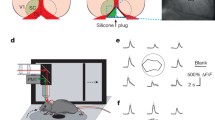Summary
Stimulus dependence of ocular dominance of 31 deep-layer complex cells was assessed from detailed monocular directional tuning curves for motion of bar stimuli or fields of static visual noise, in area 17 of normal adult cats, lightly anaesthetised with N2O/O2 supplemented with pentobarbitone. Virtually all cells were binocularly driven, with the anticipated ocular dominance distribution. Interocular differences in directional bias and sharpness of directional tuning for noise were observed in eleven cells, whereas preferred direction and sharpness of tuning for bar stimuli were similar for each eye. In the majority of cells (20/31), any differences between noise and bar tuning in one eye were replicated in the other. Ocular dominance of about half the cells (17/31) for noise and for bar motion was similar, or marginally shifted by up to one ocular dominance group. Substantial shifts in ocular dominance were seen in 14 cells — by up to two ocular dominance groups in 12 cells and by up to three ocular dominance groups in two cells. In three cases these shifts involved a reversal of eye dominance. Notwithstanding these changes, there were no obvious trends in shifts of ocular dominance in favour of the ipsilateral or contralateral eye, nor was there any tendency towards increased binocularity for noise.
Similar content being viewed by others
References
Duffy, F.H., Snodgrass, S.R., Burchfiel, J.L., Conway, J.L.: Bicuculline reversal of deprivation amblyopia in the cat. Nature 260, 256–257 (1976)
Gilbert, C.D.: Laminar differences in receptive field properties of cells in cat primary visual cortex. J. Physiol. (Lond.) 268, 391–421 (1977)
Groos, G.A., Hammond, P., MacKay, D.M.: Polar responsiveness of cells in cat striate cortex to motion of bars and of textured patterns. J. Physiol. (Lond.) 260, 47–48P (1976)
Hammond, P., MacKay, D.M.: Differential responses of cat visual cortical cells to textured stimuli. Exp. Brain Res. 22, 427–430 (1975)
Hammond, P., MacKay, D.M.: Interrelations between cat visual cortical cells revealed by use of textured stimuli. 7th International Neurobiology Meeting: Afferent and intrinsic organization of laminated structures in the brain; Göttingen, 15–19 September, 1975. Exp. Brain Res. [Suppl.] 1, 397–402 (1976)
Hammond, P., MacKay, D.M.: Differential responsiveness of simple and complex cells in cat striate cortex to visual texture. Exp. Brain Res. 30, 275–296 (1977)
Hammond, P.: On the use of nitrous oxide/oxygen mixtures for anaesthesia in cats. J. Physiol. (Lond.) 275, 64P (1978a)
Hammond, P.: Inadequacy of nitrous oxide/oxygen mixtures for maintaining anaesthesia in cats: satisfactory alternatives. Pain 5, 143–151 (1978b)
Hammond, P.: Lability of ocular dominance of complex cells in cat striate cortex. European Brain and Behaviour Society Annual Meeting, 5–8 July, 1978. Exp. Brain Res. 32, 18 (1978c)
Hammond, P.: Directional tuning of complex cells in cat striate cortex. 2nd European Neuroscience Meeting, Florence, 4–8 September 1978. Neurosci. Lett. [Suppl.] 1, 373 (1978d)
Hammond, P.: Directional tuning of complex cells in area 17 of the feline visual cortex. J. Physiol. (Lond.) 285, 479–491 (1978e)
Hammond, P., Andrews, D.P.: Orientation tuning of cells in areas 17 and 18 of the cat's visual cortex. Exp. Brain Res. 31, 341–351 (1978a)
Hammond, P., Andrews, D.P.: Collinearity tolerance of cells in areas 17 and 18 of the cat's visual cortex: relative sensitivity to straight lines and chevrons. Exp. Brain Res. 31, 329–339 (1978b)
Hubel, D.H., Wiesel, T.N.: Receptive fields, binocular interaction and functional architecture in the cat's visual cortex. J. Physiol. (Lond.) 160, 106–154 (1962)
Hubel, D.H., Wiesel, T.N.: The period of susceptibility to the physiological effects of unilateral eye closure in kittens. J. Physiol. (Lond.) 206, 419–436 (1970)
Hubel, D.H., Wiesel, T.N., LeVay, S.: Functional architecture of area 17 in normal and monocularly deprived macaque monkeys. Cold Spring Harbour Symp. Quant. Biol. 40, 581–590 (1975)
Hubel, D.H., Wiesel, T.N., LeVay, S.: Columnar organization of area 17 in normal and monocularly deprived macaque monkeys. Exp. Brain Res. [Suppl.] 1, 356–361 (1976)
Kratz, K.E., Spear, P.D., Smith, D.C.: Post-critical period reversal of effects of monocular deprivation on striate cortex cells in the cat. J. Neurophysiol. 39, 501–511 (1976)
LeVay, S., Hubel, D.H., Wiesel, T.N.: The pattern of ocular dominance columns in macaque visual cortex revealed by reduced silver stain. J. Comp. Neurol. 159, 559–576 (1975)
LeVay, S., Stryker, M.P., Shatz, C.J.: Ocular dominance columns and their development in layer IV of the cat's visual cortex: a quantitative study. J. Comp. Neurol. 179, 223–144 (1978)
MacKay, D.M., Yates, S.R.: Textured kinetic stimuli for use in visual neurophysiology: an inexpensive and versatile electronic display. J. Physiol. (Lond.) 252, 10–11 (1975)
Patel, H.H., Sillito, A.M.: Inhibition and the normal ocular dominance distribution in cat visual cortex. J. Physiol. (Lond.) 280, 48–49 (1978)
Schiller, P.H., Finlay, Barbara L., Volman, Susan F.: Quantitative studies of single-cell properties in monkey striate cortex. II. Orientation specificity and ocular dominance. J. Neurophysiol. 39, 1320–1333 (1976a)
Schiller, P.H., Finlay, Barbara L., Volman, Susan F.: Quantitative studies of single-cell properties in monkey striate cortex. V. Multivariate statistical analyses and models. J. Neurophysiol. 39, 1362–1374 (1976b)
Sillito, A.M.: The contribution of inhibitory mechanisms to the receptive field properties of neurones in the striate cortex of the cat. J. Physiol. (Lond.) 250, 305–329 (1975)
Sillito, A.M.: Inhibitory processes underlying the directional specificity of simple, complex, and hypercomplex cells in the cat's visual cortex. J. Physiol. (Lond.) 271, 699–720 (1977)
Wiesel, T.N., Hubel, D.H.: Single cell responses instriate cortex of kittens deprived of vision in one eye. J. Neurophysiol. 26, 1003–1017 (1963)
Wiesel, T.N., Hubel, D.H.: Comparison of the effects of unilateral and bilateral eye closure on cortical unit responses in kittens. J. Neurophysiol. 28, 1029–1040 (1965)
Wiesel, T.N., Hubel, D.H., Lam, D.M.K.: Autoradiographic demonstration of ocular-dominance columns in the monkey striate cortex by means of transneuronal transport. Brain Res. 79, 273–279 (1974)
Author information
Authors and Affiliations
Rights and permissions
About this article
Cite this article
Hammond, P. Stimulus dependence of ocular dominance of complex cells in area 17 of the feline visual cortex. Exp Brain Res 35, 583–589 (1979). https://doi.org/10.1007/BF00236773
Received:
Issue Date:
DOI: https://doi.org/10.1007/BF00236773




